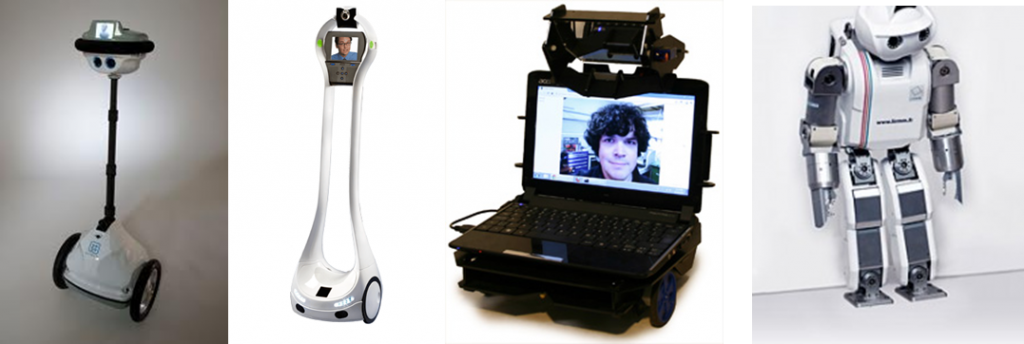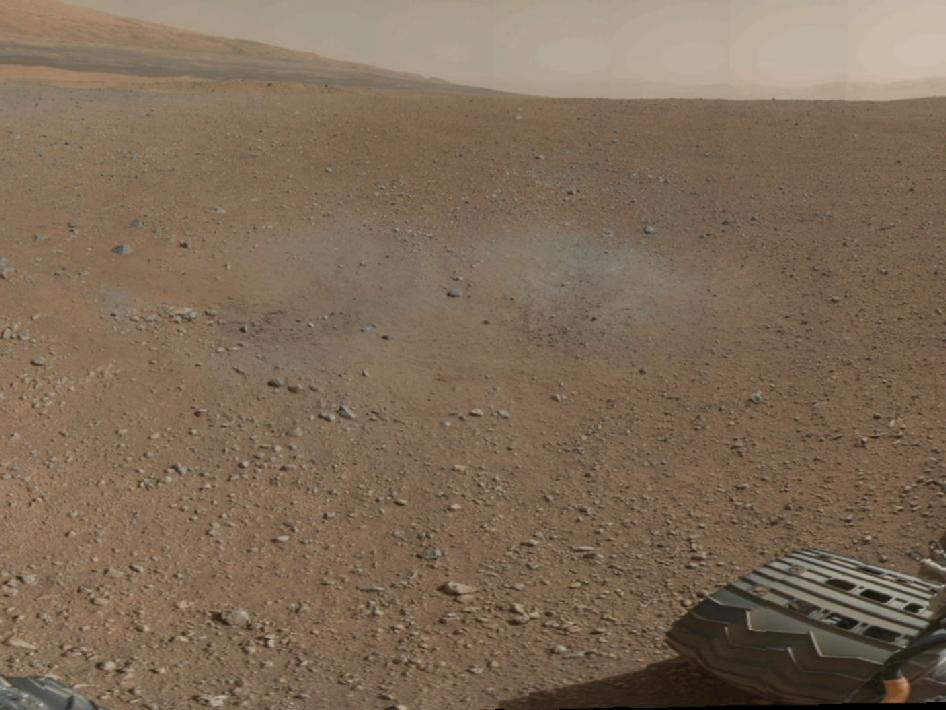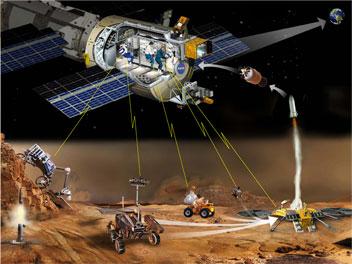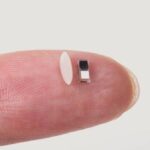In 2100 the workplace will look far different from what we see today although we can start peeking into the future by looking at a number of new technologies that are emerging. These innovations speak to a world where telepresence replaces being on the scene. The technology combines robotics, high speed telecommunications, artificial intelligence and avatars.
Anybots, VGo Communications Inc., Xaxxon Technologies, iRobot Corp. and CNRS-AIST JRL are among the pioneers in creating telepresence in the workplace. They are making it possible today to work from home while interacting with others almost anywhere on the planet through machines. Imagine reaching out and touching an object remotely and feeling it through a telepresence interface. That is what some of these technological innovators are bringing to the world of work. We, through them, are being given the ability to be in many places at once, self projecting our presence whether done through one or more robots or through avatars.

Much of the work by these companies is focused on providing telepresence in business offices. But office jobs are not the place where telepresence technology should have its greatest impact. Instead telepresence will happen in workplaces where human direct presence is at extreme risk. What type of places are we talking about?
- Ocean floors, particularly in deep water for servicing cables, drilling seafloor infrastructure, salvage and rescue operations
- Inside nuclear reactors to do maintenance or emergency procedures in the event of an accident
- Inside buildings afire or damaged by earthquakes to perform search and rescue
- Deep mines for mineral extraction where environmental conditions are too extreme for humans to tolerate
- Remote communities for medical intervention to perform routine examinations, testing or surgical interventions
- Outer space and on the surfaces of planets, moons, asteroids, comets and even stars
Space and Telepresence – Going Where No Human Has Gone Before
Ten space agencies have formed a long-term plan for human activity beyond Earth. In every case telepresence and robotics are deemed to play an important role.
In a recent set of comment exchanges with one of my readers he and I have debated the value of human presence in space. He argues that artificial intelligence, robots and telepresence is sufficient for us to explore the Moon, near-Earth asteroids and Mars. He sees no need for actual human presence arguing that the hazards associated with space and the costs represent undue risk and a poor investment. In some respects I agree that human space exploration beyond low-Earth orbit and long-term habitation of space, the Moon or Mars pose significant risk for those human pioneers who set out to achieve these objectives. But, knowing humans, that won’t stop us from going and being there in person.
But he is right. Telepresence will extend our reach to many areas in space where robots dare to tread and where humans cannot. Even today we experiment with Dextre and robotic arms as ways of extending ourselves beyond the confines of the International Space Station, often limiting the need to don space suits and enter the harsh vacuum that lies outside.
Telepresence will prove to be a very practical way for us to explore Deep Space. It will mean we don’t have to fight deep gravity wells created by planets and large moons. Nor will we need to build and transport fuel and heavy lift rocket technologies which we would need if humans were landing and taking off from these worlds. It will mean less expense in going into space and less risk while there.
We are already reaping benefits from telepresence in space. The technology deployed by Spirit, Opportunity, Phoenix and Curiosity on Mars allow us to experience the planet through these sophisticated machines. This is notable at this time because of the recent landing by Curiosity and our first glimpses of the Gale Crater and Mount Sharp shared with the entire world by a single robotic explorer.

Robots will continue to take our first steps on other bodies in the Solar System just as Surveyor preceded Apollo to the Moon. And robots with much greater capability will allow us to reach the surfaces and walk on Europa, Titan and other worlds in the Solar System, allowing us to see them through these sophisticated technologies.
Beyond exploration in space, what will telepresence provide us? Imagine a team of robots operating semi-autonomously on the surface of the Moon doing a number of tasks. These could include mining for materials like Helium3, or building habitations for future human occupants. The robots could be operated by one or more persons, tied together by a network and capable of implementing almost any contingency in the event something goes wrong. That same approach can be taken to managing an assembly line with multiple robots tied to a single human operator responsible for an entire manufacturing process.

Telepresence and Its Future – the Bottom Line
We are entering the age of telepresence. We, who work from our homes, telecommute using the Internet to interact with colleagues, clients, and friends. Some of us even have assumed virtual presence in worlds like Second Life where we have become avatars that interact for business and recreation. There are great economies to telepresence and as the technology improves not only will space science be the beneficiary but so will those of us working here on Earth.
We will benefit because:
- We will lower our carbon footprint. Telecommuting means fewer commutes and less emissions.
- We will increase productivity individually and collectively. Time we currently spend getting to and from work will be replaced by far more engaging activities than driving.
- Telepresence will allow us to reduce the size of our industrial plants. No need for a big parking lot if more of us can work remotely. No need to have an infrastructure to support a workforce in place when most of us will be interacting virtually among ourselves and with intelligent machines.
- Telepresence will make us virtually mobile. That means whether our factory is here on Earth, or on the Moon or Mars, we physically will not have to relocate because we can be anywhere our machines and telepresence takes us.









Len says: “4.Telepresence will make us virtually mobile. That means whether our factory is here on Earth, or on the Moon or Mars, we physically will not have to relocate because we can be anywhere our machines and telepresence takes us.”
All the evidence suggests that the keys to understanding how the space future will develop are grounded on a few simple precepts, that are not yet commonly received.
1. While not yet susceptible to formal “proof” in the most rigorous mathematical sense, until proven otherwise we should judge the Church-Turing Thesis valid as it applies to AI theory. In principle some algorithm can precisely describe every physical process. Turing computers can in principle execute any conceivable algorithm. Hence one can say that a general purpose Turing computer of sufficient power can execute algorithms that precisely model absolutely every possible physical process, and that includes every possible physical process occurring within the hominid brain (Given the addition of a simple hardware true random generator, which was well implemented in some Intel motherboards a decade ago, and is presently included in every VIA C3 microprocessor. See: http://en.wikipedia.org/wiki/Hardware_random_number_generator ) A true rnd generator must be added to the Turing Computer to eliminate purely deterministic outcomes. Because non-deterministic factors influence processes in the physical brain, the abstract hominid mind has “free will.” This is a trivial addition that I introduce to the fundamental Church-Turing Thesis only to refute false objections that “computers cannot exercise free will.” The Church-Turing Thesis argues that not only is strong electronic AI possible, but electronic AI much stronger than organic brain AI is possible.
2. Our human personhood/conscious awareness itself is a sort of natural telepresence. As we apprehend the optical world around us, do our minds ever consciously consider that our eyes are merely organic cameras arbitrarily connected to our brains through electronic impulses carried only a few inches by optical nerves? How would our streams of visual consciousness be different in quality if our two organic cameras were physically located a few feet distant from our brains. What if the organic cameras were a few kilometers distant from our brains? What if the cameras were millions or billions of miles distant? Would not our conscious awareness suppose itself located wherever the cameras/eyes are located? If, instead of organic systems, our eyes were artificial mechanical contraptions, as long as the functions and resolution closely mimic our organic eyes, our minds could make no practical distinction. So those considerations suggest the powerful dictums: “All reality is virtual and all intelligence is artificial (derived from symbolic manipulation).
3. NASA’s Kepler mission now gives overwhelming evidence that our own Milky Way Galaxy includes hundreds of billions of planets, millions of which produce conditions that would support life. So those facts must be contrasted with the fair question known as the Fermi Paradox, “where are the space aliens?”
Those who are keen on the notion of interstellar travel, communication with advanced space races, and man living in space are not going to like the answer: Without strong electronic AI it’s physically impossible for organic brain based beings to travel into space very far off their planets of origin. But that’s a Catch-22. When electronic AI reaches the scale of sophistication needed to construct space habitats for hominids, it has already reached the scale where high-resolution virtual reality modeling instantly transports the hominid conscious awareness anywhere at all. Electronic AI can model entire galaxies and instantly transport the model into the hominid brain. The hominid brain is not heading out into the galaxy; the galaxy is heading into the hominid brain. And so it is throughout the universe; millions of advanced races are out there mind-melded with strong electronic AI systems, and they are not going to waste much time and energy on pointless physical journeys of light-years. The space aliens aren’t coming here and hominids aren’t going there.
Mankind will eventually venture into interplanetary space after electronic AI systems have paved the way. It’s true that a good high-resolution link between a distant camera and the human brain provides the mind with with the passive “being there” sensation. But what if the mind that supposes it is there wants to reach out its hands and change something physical? If the organic brain that supports conscious awareness is located on Earth and its mechanical eyes are located on Mars, the optical feed is limited to light speed, which means the hominid mind is perceiving the optical impressions of Mars delayed by over 30-minutes. Suppose the Mars located “eyes” detect an approaching dust storm and the best survival action would be to move the eyes to shelter. The earth-based mind could immediately send the “seek shelter” command to the robot system on Mars, but alas to no avail because it will take another 30-minutes for the command to reach Mars, by which time the storm would have already destroyed the remote robotic system.
If humanity is to have any timely control over its distant sensory extensions on Mars, it will have to go in physical person, and cut the communication distance down to seconds or less. A hominid can comfortably set on Earth and “be” working in a factory on the moon through robotic sensory extensions, but that is only because the communication cycle is only a couple of seconds. If we are to do anything significant on Mars and in the Asteroids we must either send autonomous electronic AI representatives that are at least as smart as we are, or go in person. But that scale of electronic AI is strong enough to instantly create any desired virtual reality on Earth or near Earth space habitat. It’s reasonable to suppose humanity will eventually join all the other millions of advanced species that decided to bring the universe to themselves, rather than to bring themselves to the universe. We should give Fermi the honest answer: “They are mostly at home where they belong.”
Like you I believe that interstellar travel represents a challenge that is beyond physical laws as we understand them today.The distances even at sub-light speeds would make such journeys impractical unless there were no return trip planned. For our physical presence we may find Earth-based humans confined to our neighbours here in the Solar System. Even then, as you point out, telepresence technology will only work effectively when communication latency is minimized. Human telepresence on Mars would best be served by humans communicating with robots from a nearby base either in orbit above the planet, on one of the moons of Mars or from a surface habitation. Even if we were to upload our intelligence into robots and have them in place on remote worlds the experiences these robots would feel could not be shared in real time. Unfortunately the laws of physics and the speed of light prevail.
Len says: Human telepresence on Mars would best be served by humans communicating with robots from a nearby base either in orbit above the planet, on one of the moons of Mars or from a surface habitation.”
Obviously surface bases would practically standardize and effectively trivialize robotic telepresence communication latency. But for all practical purposes the surface of Mars is in a near vacuum often filled with deadly radiation. To compound the problems of vacuum and radiation, the Mars surface gravity is only ~ 38% that of Earth. It’s not yet scientifically settled whether humans can survive for years in gravity that low without serious health damage. Humans on the Martian surface would have to live inside pressurized containments that provide normal atmosphere and radiation shielding. That would likely amount to living constantly inside an underground cave, with inadequate gravity, but with low robotic telepresence latency. That would be the cheapest and quickest scheme to put men on Mars, but it sounds like a one-way trip to a cramped dim cave under the Martian surface, where within a decade or so the Mars traveler would expire from cardiopulmonary failure.
Still, there are millions of weird heroic humans that would volunteer to be among the first ten to go. But it’s likely the number of Mars surface volunteers would shrink rapidly after the Earth-bound humans receive and consider the reports from the first ten. The low gravity seems to preclude multi-generational population in the subsurface caves.
We just don’t yet have the data about the low gravity problem, and we won’t have it until we build at least one 600-foot, or larger, diameter spinning wheel space habitat. After a few decades of constant hominid habitation with variable spin rates, Earth science would know for sure. Right now it’s anyone’s guess. I’m guessing it’s about 0.8 g for sustained multi-generation habitation without health injury. Might work out 0.8 would allow an extra decade of senescence added to normal lifespan. In any case it seems unlikely we would be able to solve the gravity problem on the Mars surface. So the surefire scheme is a spinning 600-foot (or larger) diameter orbital space habitat/ship in the radiation shadow of the mass of Deimos. This approach would be more costly with at least a decade of delay.
Ideally the Mars orbital spinning space habitat would be in synchronous orbit around the Martian Equator (an orbit near that of the present orbit of Deimos), so habitat construction and orbital positioning would require little expenditure of reactive mass and energy, and material mined from Deimos could provide the solar radiation shadow. The synchronous orbit would produce constant and trivial communication latency to robotic telepresence on the surface. A spinning orbital habitat station would allow for extremely expensive return trips to Earth. But with advanced electronic AI mind-meld and high-resolution holodeck virtual reality, it seems unlikely the orbiting organic Kings of Mars would have good reasons to ever return to Earth.
Ray Kurzweil raises this issue with his conjecture that mind-meld with a superior electronic person would preclude most desire for normal persistent marital relationships and human associations. If a human could mind meld with a de facto God, why would he want to mind meld, or even share a meal, with a seriously flawed mortal? Wouldn’t most literate people honestly suppose it’s better to dine with a good book than a bad person? Interestingly, Nietzsche sort of anticipated this question a century ago with the scene from Zarathustra where the hero starts trekking back down the mountain and the old hermit seriously asks (paraphrased), “Why are you going back down; stay up here and mind-meld with God.” But the hero shrugs him off, and muses as he continues his descent, “Is it possible, can it be, has not the old hermit heard that God is dead?”
Len says: “Like you I believe that interstellar travel represents a challenge that is beyond physical laws as we understand them today. The distances even at sub-light speeds would make such journeys impractical unless there were no return trip planned.”
Well, that would depend on just “what” is traveling. Since I hold that the Church-Turing Thesis (with true rnd added) should be considered valid, it follows that the mental essence of personhood consists merely of very many mathematical relationships, all of which can be executed by a Turing computer. Any physical system that precisely actualizes the many relationships describing any particular person is for all practical purposes that person. While there are indeed nearly insurmountable physical difficulties in trying to transport massive physical systems between the stars, the transportation of mathematical relationships is relatively easy, especially if there is no hurry.
Once Earth science advances to the point where a hominid person’s essence can be recorded as symbolic mathematical relationships, and duplicated and stored at will, all that is left to achieve de facto immortality of personhood, and interstellar travel, is to develop technology to build physical systems to actualize those relationships. So, we could think of storing symbolic relationships on a very durable substrate such as a microscopic chip of diamond, and accelerating the diamond chip to 1/10 light speed. Millions of such chips might be produced and sown randomly among the stars. Should any very advanced race of distant star space aliens come across such a chip of diamond, they could in principle construct a physical system to express the symbolic relationships. The finding of the microscopic chip would seem to raise the “find the needle in the haystack” problem to a whole new cosmological level, but it’s not impossible.
Obviously, a constant radio broadcast of the mathematical relationships describing personhood, along with instructions for constructing the physical systems to actualize the relationships, could transport humanity at light-speed out into the universe to be received and acted upon by any technically advanced space aliens interested in meeting human persons. Seems likely this method of interstellar travel is ordinarily implemented throughout the universe.
Taken to the next level, an interstellar space faring race would use the random seeding of relationship persons to deliberately establish receiver stations where the physical systems to actualize the relationships are constructed. Then the interstellar transport of “persons” to particular locations and times becomes a deliberate trip.
One could envision a small 1/10 light-speed ship that carries the diamond chip persons, along with AI robotic systems to actualize physical bodies out of materials found at destination stars. During the prolonged interstellar voyages, persons stored on diamond chips are not dead, they are merely spiritual potentials awaiting resurrection thousands, or millions, of years hence and vastly distant from their physical locations of storage and points of departure.
It’s plausible to postulate that interstellar space is seething with signals that describe alien persons, but the signals are encrypted so that marginal races lacking sufficient technology to build the physical actualization systems will not detect them. One can envision weak encryption systems that encourage demonic races to intercept the personhood signals, develop actualization systems, and then transform the technology into cosmological cancer. The SETI Project is very unlikely to discover the “Wow” signal, because the signal is deeply encrypted. Humanity will not discover the signal before it can put a person on a diamond chip and resurrect him into physical form. Humanity needs to do a lot more work on the ground before it tries to go into space.
Some very interesting ideas brought up in your speculation about the future. Will this be possible by 2100? What do you think?
Len asks: “Will this be possible by 2100? What do you think?”
Seems likely that the “mind on a diamond” concept, and the deliberate creation of physical systems to actualize the symbolic relationships, could in principle be actualized by then. But actualization would require the same vast scale of resources that a manned Mars mission would consume. If we send men to Mars in the next several decades, billions will suffer and die on Earth because the resources were wastefully diverted away from development of strong electronic AI and the “person on a chip” project. Obvious requisites would include electronic AI “persons” who are much “smarter” than hominids. In the past, Ray Kurzweil has done a pretty good job of predicting realization of technical timelines. He reckons somewhere around 2030 electronic AI will reach the level of the smartest hominids, and after that the pace of subsequent electronic AI development will go exponential. (That’s fairly ambiguous because by 2030 the smartest hominids will have already significantly mind-melded with electronic AI systems. It will be virtually impossible to tell where the hominid minds end and the electronic AI minds begin.) Kurzweil is personally trying to cheat his impending death by development of advanced technologies. I figure he’s going to die, because the technology won’t arrive in time to save either him, or me. In principle, barring intervention by advanced beings, it will eventually arrive, probably within the next couple of centuries.
The possible patterns of development encompass many imponderables. The future is not deterministic. There is possibility from the quantum level on up.
The proposition of “a person on a chip” boils down to “personal immortality” through technical means. In contrast to the implications of personal immortality, questions of interstellar transportation of “persons” shrink into insignificance. If durable reproducible chips can store the essential mental aspects of hominid persons indefinitely, then the relationships themselves are in principle subject to “editing” before “reproduction” or “resurrection.” Why would a race of immortal advanced space aliens wish the proliferation of a technology that threatens the spread of countless embodied demons and immortal devils throughout the cosmos? Wouldn’t the mental personhood storage and physical resurrection process necessarily incorporate correction of defects and deficits? What authority would set the standards and judge mental defects and deficits, and what sort of corrections should or would be implemented? What is the optimum population of physically actualized immortal persons within the Milky Way Galaxy? I’m guessing that only the introduction of at least some elements of “intervention” by as yet unknown agents of some powerful moral intelligence of cosmological scale can adequately answer the Fermi Paradox question.
The physical universe might well be deliberately designed so that emerging races cannot travel into interstellar space before achieving personal immortality through AI technology, but “higher powers” prohibit unrestrained physical expansion outward into interstellar space. The rules allow limitless expansion into created dimensions of inner virtual reality. The immortal person that wishes travel between the stars will need to obtain a license issued only after submission to the “higher power’s” editing of “defects and deficits.”
In short, only the immortal angels can travel between the stars. If mortal men want to travel between the stars, they must first somehow transform into immortal angels.
Maybe all intelligent species that survive their destructive technology phase become immortal. And maybe all of them integrate with technology to experience extra-solar worlds that physically their limited bodies and the laws of physics make impossible to reach. Those unknown agents may be intelligent species that have had a few million years head start on us. After all it took 4 billion plus years for Earth to develop differentiated species from single celled life to the multicellular complex biology of creatures like us. What if somewhere else, on another planet, circling another star, this happened 100 million or 500 million years sooner? Higher powers? I would think so from our perspective
Len says: “After all it took 4 billion plus years for Earth to develop differentiated species from single celled life to the multicellular complex biology of creatures like us. What if somewhere else, on another planet, circling another star, this happened 100 million or 500 million years sooner? Higher powers? I would think so from our perspective.”
Well, the best astrophysical evidence suggests the optical universe is about 13.7 billion years old, and that organic life requires heavier elements that are synthesized only in solar furnaces of massive first generation stars that self-destructed in ancient super novas. Given that life self-organizes spontaneously out of the nature of elemental atoms and the “laws” of physics, organic life would have first emerged in every galaxy around 2nd generation stars some 12-billion years ago. But very hostile radiation from frequent supernovas would have constantly bombarded and exterminated early organic life on the surface of planets. So we might reasonably suppose self-conscious organic life might be no older than about 10-billion years, by which time the early universe had very much calmed down in terms of supernova frequency. Taking the 4-billion-year-old life on Earth as representative, we must then conclude some interstellar races of beings have a 6-billion-year evolutionary head start on mankind.
Once a race achieves the technology of deliberate symbolic expression and duplication of personhood, then it is not just racial immortality that is achieved, but also personal immortality, and the speed of further technological development goes exponential. So there is a reasonable case to be made that at least 6-billion years in the past every galaxy of stars generated races of “archangels.”
Since galaxies of stars are no more than 400,000-light-years in expanse, it seems likely that 6-billion years is plenty of time for Milky Way archangels to have pervaded the entire galaxy. The case may be that Gods do not create universes, but rather universes create Gods. But, whatever the case, all that was settled long before the Sol planetary system was formed, and mankind is silly to entertain naïve atheism. It’s much more likely that the Milky Way “belongs” to immortal archangels than to mortal humanity. Mankind’s prospects of prevailing in conflicts of interests against archangels are less than an ant’s chances of impregnating an elephant.
Being an atheist myself I fully appreciate that we are potentially relative newbies here in the Milky Way, let alone in the Universe and that many intelligent civilizations have preceded the one we established here on this remote planet around quite an ordinary star.
I fully appreciate your deist references to archangels and gods, particularly the latter. Gods that are the product of evolution fused with technology leading to immortality seems very likely. We would see them as super beings if we ever encountered them. Interesting speculations. My guess is our awareness of such species with billions of years of a head start might be difficult for us to reconcile with our daily reality.
Len says: “My guess is our awareness of such species with billions of years of a head start might be difficult for us to reconcile with our daily reality.”
Might be purely impossible. The ant has no sensory equipment to image an elephant. If he gets close enough he might “see” a gray wall that sometimes moves. But the ant has no means to back off, refocus its eyes, and “see” the whole elephant. The baboon can “see” the whole elephant, dimly apprehend that the elephant is a harmless alien entity, and, from time to time, perhaps even make deliberate eye contact. But the baboon lacks sufficient mind to ever conceptualize much about the particular properties of elephants. If we think of the naturally evolved interstellar “Gods” as analogous to the elephants, humans must be more like the ants than the baboons.
Kurzweil cogently points out that “evolutionary” processes do not proceed in linear fashion. Once a species advances to the point where it can articulate and contemplate the properties of personhood and evolution, the species can willfully wrest control of its development from “natural selection” and direct its own exploding evolution through intelligent design. Then the pace of evolution might go exponential and the outcome would be purposeful rather than accidental. One billion years of evolution through intelligent design might affect changes that would take “natural selection” more than forever. We are speculating about immortal entities that have been evolving through purposeful intelligent design for 6-billion years. Yep, we are more like the ants. But, we are ants that can grasp the notion that we are ants. And we can grasp the notion that if we control our evolution through intelligent design we don’t have to stay ants much longer. We can probably reach the baboon stage in only a couple of centuries.
While it seems nearly certain the “Gods” have the power to grant immortality to ants, it’s impossible to think of any plausible reason why they should do so. Until the ants figure out how to at least make eye contact with the “Gods” it seems unlikely the “Gods” will allow them immortality.